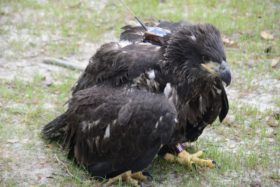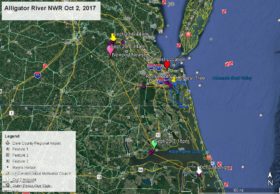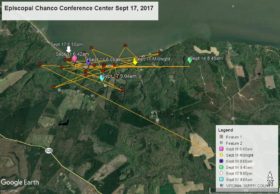Historic Bald Eagle Ground Nest
Camellia Returns to Gloucester Landfill 5/9
May 10, 2013Camellia Is Back In Chesapeake, VA May 12
May 13, 2013While flying a shorebird survey over the Virginia barrier islands on April 26, 2013, Dr Bryan Watts, Director of The Center for Conservation Biology, and Barry Truitt, Chief Conservation Scientist for The Nature Conservancy, discovered that a bald eagle pair had built a nest on the ground in the sand dunes on one of the barrier islands. In the nest were two chicks about 35 days old that appeared to be in good condition. It is likely this is the pair that had previously had a nest on an old shack. The shack was washed away by hurricane Sandy.
Ground nesting bald eagles are very rare and this is the first documented record in Virginia. A follow up aerial survey was conducted on May 9 and the eagle chicks, now about 7 weeks old, appear to be doing well. There were Diamondback Terrapin shells (turtles) in the nest. The male bald eagle was perched about 15 feet from the nest.
Photos credits Dr Bryan Watts
April 26, 2013
May 9, 2013






5 Comments
WOW… that is amazing. Wonder if Dad and DT have thought of this? :o)
This is a wonder of nature what a joy to see..making do with what they have.. When life gives you lemons ..you make lemonade Thank you Reese..
How neat is that! Congratulations on such a great find!
Fascinating
Will the fledging process for these eaglets be different because of the absence of trees? They should be very interesting to watch and see how their development process differs from tree raised eaglets. Amazing how nature can adapt to any situation.
Response – Because this is such a unique situation we will just have to wait to see how the eagles handle “branching” when there are no branches.